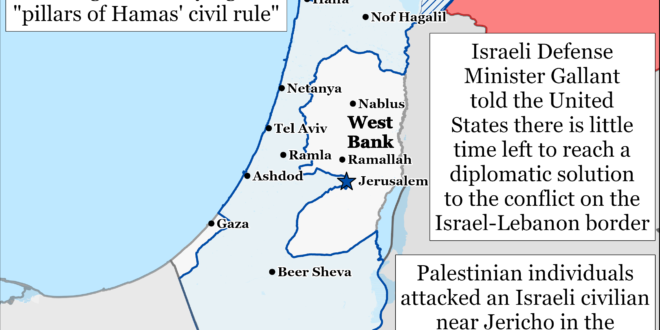Israel is refocusing its operations in the Gaza Strip to prioritize “destroying the pillars of Hamas’ civil rule. . . especially the distribution of humanitarian aid,” according to an anonymous Israeli official.[1] The official told Israeli media that controlling aid distribution enables Hamas to project the image that it still controls the Gazan population.[2] Hamas inserts itself into the aid distribution process by forcing humanitarian organizations to coordinate with Hamas affiliates and seizing aid shipments as they enter the strip.[3] Hamas has also aggressively opposed other Gazan factions from adopting a role in aid distribution given that it would jeopardize Hamas’ near monopoly of aid.[4]
Israeli officials have recently considered alternative methods to distribute aid without Hamas, especially as the IDF faces less resistance from Hamas’ military across the Gaza Strip.[5] Prime Minister Benjamin Netanyahu said on September 2 that Israel needs to find an alternative distribution mechanism in order to deprive Hamas of its ability to rule.[6] Netanyahu has reportedly ordered the IDF to examine the administrative and logistics requirements involved in the IDF assuming responsibility for aid distribution from international organizations.[7] IDF Chief of Staff Lieutenant General Herzi Halevi has reportedly opposed the IDF assuming such responsibility due to the risk it would pose to Israeli service members and because international organizations are already prepared to do so.[8]
Iran is simultaneously setting conditions to build a nuclear weapon while continuing to signal its willingness to resume nuclear negotiations with the West. Russia has increased nuclear cooperation with Iran in recent months in line with “[Iranian] ambitions to obtain atomic weapons,” according to unspecified Western officials speaking to Bloomberg on September 14.[9] It is unclear whether the Western officials meant that Iran has decided to produce a nuclear weapon or that Iran seeks to develop the capability to develop a nuclear weapon but has not actually decided to produce one. The Western officials stated that US President Joe Biden and UK Prime Minister Keir Starmer discussed on September 13 how Russia may be sharing unspecified nuclear technology and secrets with Iran in return for Iran providing Russia with ballistic missiles.[10] Iran recently delivered over 200 Fateh-360 short-range ballistic missiles to Russia on September 4.[11] US Secretary of State Antony Blinken similarly stated on September 10 that “Russia is sharing technology that Iran seeks. . . including on nuclear issues.”[12] Russian President Vladimir Putin stated that Iran and Russia have increased “peaceful nuclear cooperation” during a meeting with Iranian Supreme National Security Council Secretary Ali Akbar Ahmadian in St. Petersburg, Russia, on September 12. [13]
The Masoud Pezeshkian administration is simultaneously continuing to signal its willingness to resume nuclear negotiations with the West. Atomic Energy Organization of Iran head Mohammad Eslami emphasized that President Pezeshkian seeks to “expand constructive interactions” with the International Atomic Energy Agency (IAEA) in a speech at the 68th IAEA General Conference in Vienna, Austria, on September 16. Pezeshkian separately suggested that Iran could engage in direct talks with the United States if Washington abandons its “hostile” policy toward Iran. These statements do not necessarily contradict Iran’s growing nuclear cooperation with Russia. Iran could seek Russian assistance with its nuclear program to try to increase pressure on the West and build leverage for itself in future negotiations.
The Islamic Revolutionary Guards Corps (IRGC) Aerospace Force launched the Chamran-1 satellite into orbit on September 14.[14] The IRGC Aerospace Force and Iran Electronics Industries, which operates under the Iranian Defense and Armed Forces Logistics Ministry, jointly designed and built the Chamran-1 satellite, which weighs 60 kilograms.[15] The Ghaem-100 space launch vehicle (SLV) launched the Chamran-1 satellite into a 550-kilometer orbit.[16] The Ghaem-100 SLV previously launched the Soraya satellite into a 750-kilometer orbit in January 2024.[17] Iran can use such satellites to support intelligence collection and attack targeting. Iranian state media previously reported in 2020 and 2022 that the IRGC used its satellites to collect intelligence on US military positions in the region.[18] IRGC Aerospace Force Salman Farsi Space Commander Brigadier General Ali Jafar Abadi stated on September 15 that Iran will launch the Ghaem-105 SLV by the end of the current Persian calendar year, which ends in March 2025.[19] Russia has previously assisted Iran with its SLV and missile program and launched Iranian satellites into orbit on Iran’s behalf.[20]
Iranian President Masoud Pezeshkian discussed parts of his agenda to strengthen Iran’s economic relationships abroad during his first press conference on September 16.[21] Pezeshkian advocated for Iran complying with the international money laundering and financial transparency standards set by the Financial Action Task Force (FATF) in order to attract foreign investment and increase economic growth.[22] Pezeshkian previously said that Iran needs over 100 billion US dollars in foreign investment in order to reach eight-percent annual economic growth.[23] The FATF blacklisted Iran in February 2020 for failing to adhere to the international financing standards.[24] Former moderate Iranian President Hassan Rouhani similarly advocated for resolving issues with the FATF but failed due to hardliner opposition.[25] Pezeshkian separately in his press conference reiterated his call for “removing borders with neighbors” in a fashion similar to the European Union.[26] He said that Islamic countries would maintain “their own government[s] and authority” but that removing borders would facilitate travel among Muslims in the region and “improve the security and development of the economy and culture of the Islamic world.” This proposal reflects the Iranian desire for greater economic integration with neighboring states, particularly Iraq and Syria, especially given the role that such integration could play in mitigating the impact of international sanctions. Pezeshkian first presented this idea during his first official visit to Iraq on September 11. Pezeshkian expressed his commitment to continue pursuing the development of relations with China, Russia, and regional countries.
Pezeshkian lastly reiterated that Iran will not accept constraints on its missile program.[27] Pezeshkian was referencing the notion that the West could demand that Iran limit its missile development in future nuclear negotiations. Iranian officials have long maintained that they will not grant any concessions on the missile program.
Hamas leader Yahya Sinwar sent a letter to Houthi leader Abdulmalik al Houthi, according to Houthi media on September 15, emphasizing that the Hamas is “well” and calling Israeli announcements claiming the opposite “psychological warfare.”[28] Sinwar also congratulated Abdulmalik on the Houthi ballistic missile attack into Israel on September 14 and claimed that combined efforts with the Houthis, Lebanese Hezbollah, and Iranian-backed Iraqi militias will “break” and “defeat” Israel. Israeli officials have made several recent statements on Hamas’ degradation in the Gaza Strip that Sinwar could be referencing to Abdulmalik. Israeli Defense Minister Yoav Gallant stated on September 10 that Hamas is no longer an organized military force in the Gaza Strip.[29] The IDF Southern Command’s fire control commander similarly said on September 11 that Hamas no longer functions as a conventional military organization but added that the IDF requires another year to fully destroy Hamas’ military and governance capabilities.[30] Lebanese Hezbollah-affiliated media claimed Sinwar also sent a letter to Hezbollah Secretary General Hassan Nasrallah at some point in August or September 2024, asserting that Hamas’ fight against Israel will continue until Israel is defeated.[31]
Key Takeaways:
- Gaza Strip: Israel is refocusing its operations in the Gaza Strip to prioritize “destroying the pillars of Hamas’ civil rule. . . especially the distribution of humanitarian aid.” An Israeli official said that controlling aid distribution allows Hamas to project the image that it still controls the Gazan population.
- Iranian nuclear program: Iran is simultaneously setting conditions to build a nuclear weapon while continuing to signal openness to nuclear negotiations with the West. Russia has increased nuclear cooperation with Iran in line with Iranian “ambitions to obtain atomic weapons,” according to Western media.
- Iranian economy: Iranian President Masoud Pezeshkian discussed parts of his agenda to strengthen Iran’s economic relationships abroad during his first press conference. Pezeshkian advocated for Iran complying with international money laundering and financial transparency standards, which Iranian hardliners have historically opposed.
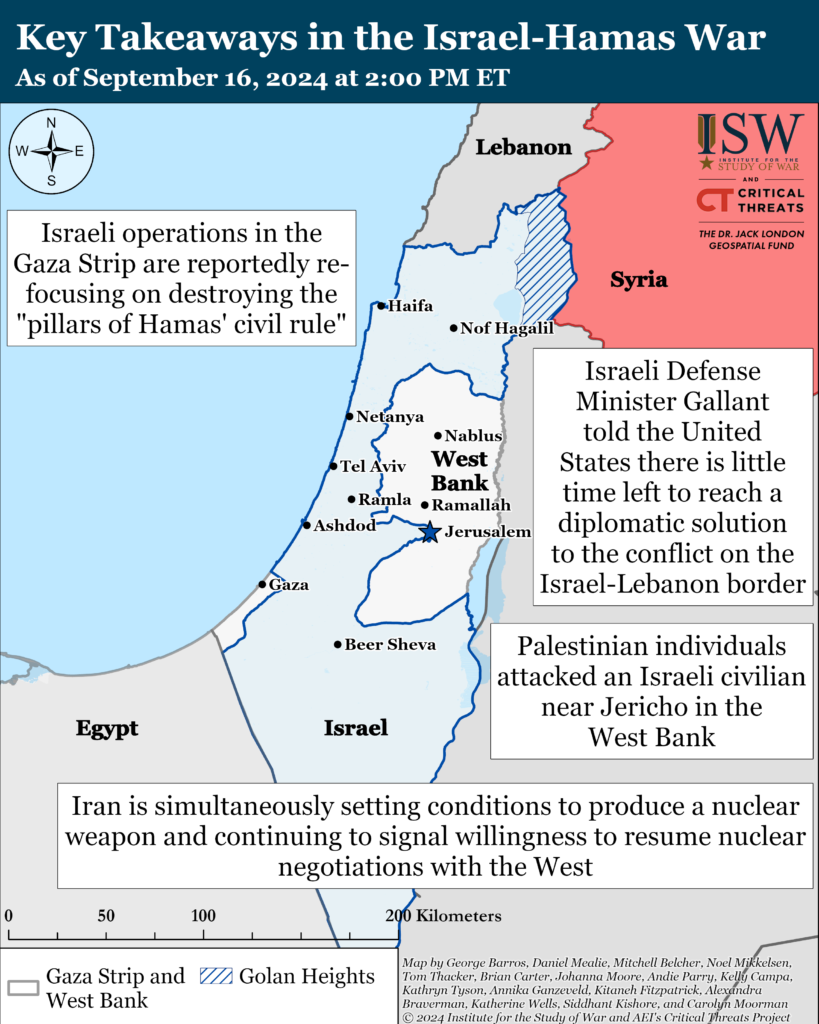
Gaza Strip
Axis of Resistance objectives:
Erode the will of the Israeli political establishment and public to sustain clearing operations in the Gaza Strip
Reestablish Hamas as the governing authority in the Gaza Strip
The IDF likely continued operations around the Netzarim Corridor, south of Gaza City, on September 16. Palestinian sources reported that Israeli forces continued operations in southern Gaza City on September 16.[32] A Palestinian journalist reported small arms fire and shelling in Tal al Hawa and Sheikh Ijlin, southern Gaza City.[33] The journalist also reported that Israeli forces operated near Kuwait Circle in Zaytoun.[34] The IDF last confirmed its forces operated in Zaytoun on September 9 to raid militia targets, kill dozens of Palestinian fighters, and destroy tunnel shafts and machinery for manufacturing weapons.[35] IDF operations in southern Zaytoun support the IDF’s continued presence on the Netzarim Corridor.
The IDF also announced that its 5th (Res.) Brigade began operations in the Gaza Strip.[36] The IDF said on September 16 that the 5th Brigade will operate under the command of the IDF 252nd Division, which has been deployed around the Netzarim Corridor since July 27.[37] The 252nd division was comprised of two brigade combat teams and the 454th Artillery Brigade.[38] It is unclear at this time whether the IDF has withdrawn either of its combat teams, which are the 10th and 16th reservist brigades. The 5th Brigade last operated in the Gaza Strip in early February 2024.[39] The IDF said the 5th Brigade completed a series of training exercises in both open and urban environments over the past few days to prepare for the brigade’s return to Gaza.[40]
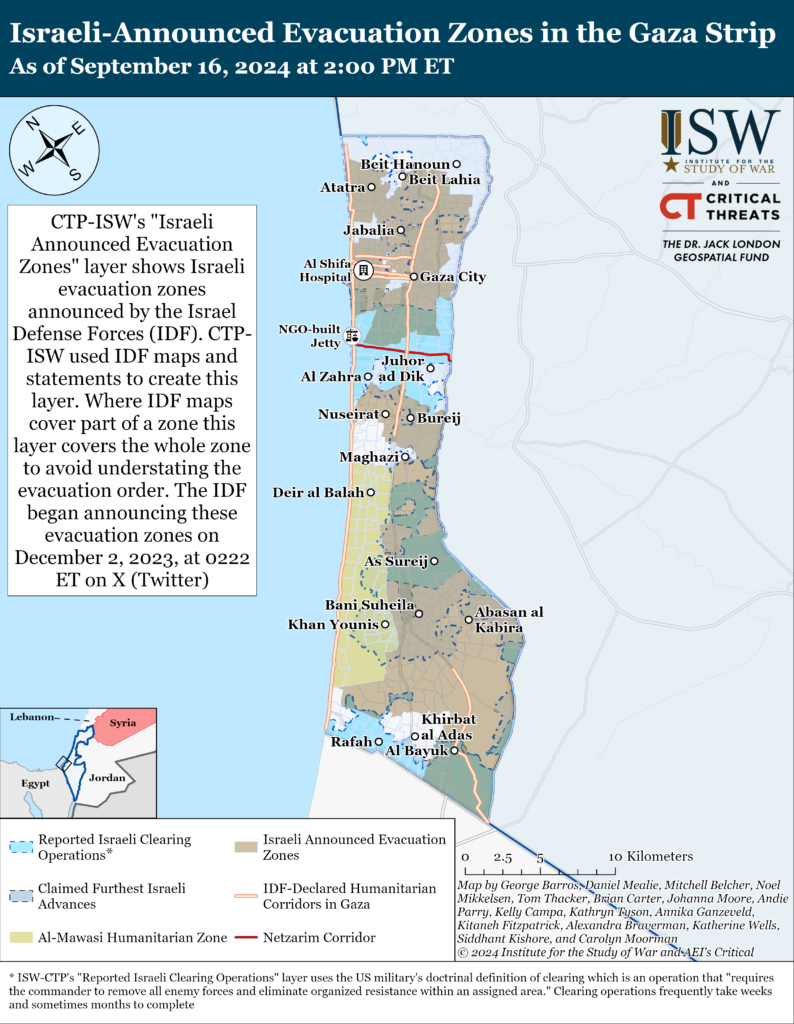

The IDF found that three Israeli hostages were likely killed as a “byproduct” of an Israeli airstrike in the Gaza Strip on November 10.[41] The IDF conducted an airstrike targeting the commander of Hamas’ Northern Gaza Brigade in Jabalia on November 10.[42] The IDF said that it had no information on hostages held in the area when it conducted the airstrike.[43]
Hamas Political Bureau member and spokesperson Osama Hamdan said on September 16 that Hamas officials and representatives from Palestinian factions will soon meet in Cairo to discuss Palestinian visions for post-war governance.[44] Hamdan did not specify which Palestinian factions would attend the talks or when they would be held. Hamas, Fatah, and other unspecified Palestinian political factions previously agreed on a vision for post-war governance of the Gaza Strip on July 23 during “intra-Palestinian reconciliation” talks in Beijing.[45] The factions signed a joint declaration establishing their intention to form “a temporary national unity government” responsible for governing the Gaza Strip and the West Bank.[46] Hamas has emphasized repeatedly in recent weeks its commitment to the Beijing Agreement’s resolutions, including reforming the Palestine Liberation Organization and rebuilding a Palestinian political system.[47] Hamas has denounced US, Israeli, and other international attempts to create alternative governance plans for the Gaza Strip.[48]
West Bank
Axis of Resistance objectives:
Establish the West Bank as a viable front against Israel
Israeli forces engaged Palestinian fighters in at least three locations in Nablus since CTP-ISW’s last data cutoff on September 15.[49] Hamas and the al Aqsa Martyrs’ Brigades separately fired small arms and detonated improvised explosive devices (IED) targeting Israeli forces in the Balata refugee camp.[50]
The IDF stated that Palestinian individuals attacked an Israeli civilian near Jericho on September 16.[51] The IDF added that the Palestinians fled to a school in Muarajat after injuring the Israeli civilian.[52] Israeli individuals then entered the school and attacked and injured the Palestinian individuals in the school.[53] The IDF and Israeli police arrived at the scene of the incident and detained several individuals.[54]
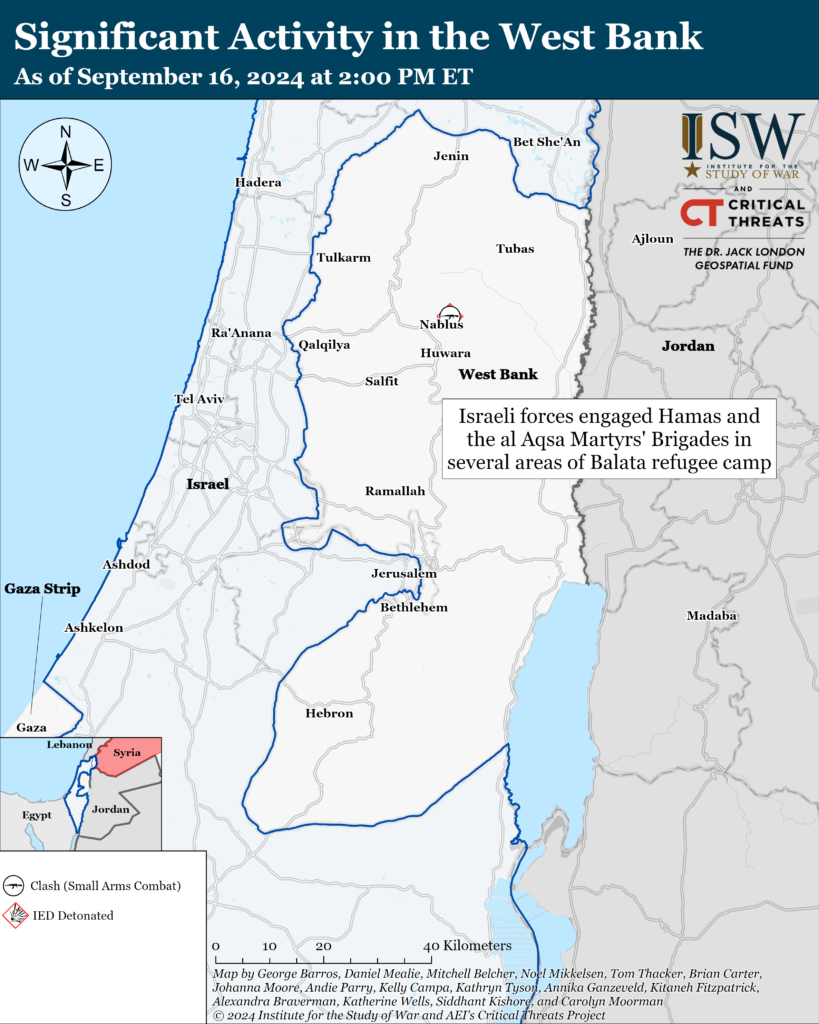
This map is not an exhaustive depiction of clashes and demonstrations in the West Bank.
Southern Lebanon and Golan Heights
Axis of Resistance objectives:
Deter Israel from conducting a ground operation into Lebanon
Prepare for an expanded and protracted conflict with Israel in the near term
Expel the United States from Syria
Lebanese Hezbollah has conducted at least 10 attacks into northern Israel since CTP-ISW’s last data cutoff on September 15.[55]
A senior US official discussed the security situation along the Israel-Lebanon border with Israeli Prime Minister Benjamin Netanyahu and Defense Minister Yoav Gallant in separate meetings on September 15 and 16.[56] Netanyahu told US Presidential Envoy Amos Hochstein during a meeting in Tel Aviv that Israel cannot return displaced Israeli residents to northern Israel ”without a fundamental change in the security situation” there.[57] Netanyahu added that Israel will ”do what is necessary” to restore security in northern Israel and return displaced residents. Gallant separately told Hochstein that the only way to return Israeli civilians to northern Israel is through military action.[58] Two sources familiar with the meetings told Axios that Hochstein warned Netanyahu and Gallant that a wider war in southern Lebanon would not help return displaced Israeli civilians to northern Israel.[59] US White House National Security Communications Advisor John Kirby told reporters on September 13 that Hochstein’s visit is meant to prevent an ”escalation and a widening of this conflict” in northern Israel.[60]
Israeli Defense Minister Yoav Gallant similarly told US Secretary of Defense Lloyd Austin on September 15 that there is little time left to reach a diplomatic solution to the conflict on the Israel-Lebanon.[61]Gallant said that ”the trajectory is clear” as long as Hezbollah continues to align with Hamas in the Gaza Strip. Austin reaffirmed the necessity of a ceasefire-hostage deal between Israel and Hamas and said that Israel should ”give diplomatic negotiations time to succeed.”[62]
The Israeli security cabinet is expected to vote on September 17 to add the return of displaced Israelis to northern Israel as an official goal of the war.[63] Israeli media reported that doing so would mark the first time that northern Israel is officially included in Israel’s stated war objectives.[64] Netanyahu said on September 12 that a political settlement alone will not return displaced Israelis to northern Israel and that Israel is “preparing for a broad campaign.”[65]
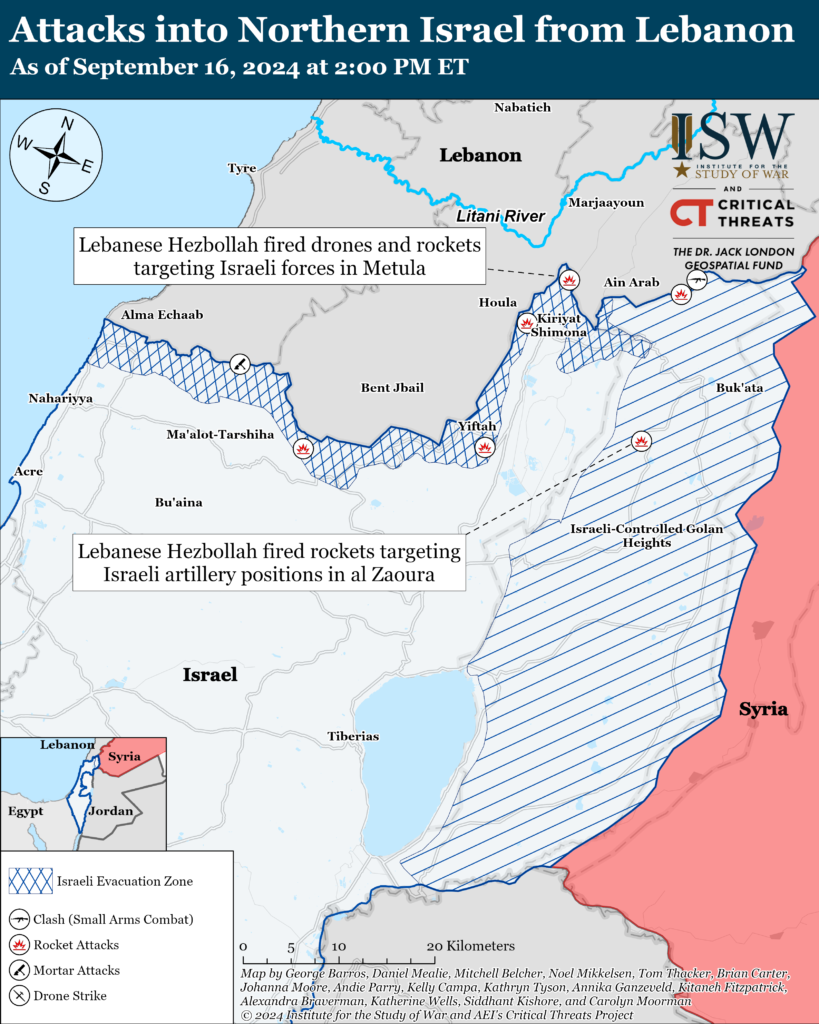
Iran and Axis of Resistance
Iranian-backed Iraqi fighters likely conducted a drone attack targeting US forces at the Rumalyn Landing Zone in Hasakah Province, Syria, on September 15.[66] Syrian opposition sources claimed that US air defenses intercepted three drones launched from Syrian regime-controlled territory in Deir ez Zor Province.[67] CTP-ISW cannot independently verify that this attack occurred. An Iranian-backed militia drone attack injured eight US service members at Rumalyn Landing Zone in August 2024.[68] CTP-ISW assessed in July 2024 that Iranian-backed Iraqi militias appear to have resumed their attack campaign targeting US forces in the Middle East.[69]
Houthi spokesperson Yahya Sarea released footage of the ballistic missile that the Houthis fired into Israel on September 14.[70] The Houthis claimed that the attack targeted an unspecified military target around Tel Aviv with a “new hypersonic missile.”[71] The IDF denied that the Houthis used a hypersonic missile, however.[72]
The Houthis claimed that they intercepted a US MQ-9 drone over Dhamar Governorate, Yemen, on September 15.[73] Houthi spokesperson Yahya Sarea claimed that the Houthis have intercepted three total MQ-9s this week and ten MQ-9s since the start of the Israel-Hamas war in October 2023. CTP-ISW cannot verify this Houthi claim.
US Central Command (CENTCOM) destroyed a missile system in Houthi-controlled Yemen on September 15.[74]
Iranian Artesh Coordination Deputy Brigadier General Habibollah Sayyari discussed naval cooperation, including joint exercises and patrols, with Russian Deputy Defense Minister Alexander Fomin on the sidelines of the Xiangshan Forum in China on September 15.[75] Sayyari and Fomin asserted that the Caspian Sea is for “peace and friendship” and emphasized the need to secure the sea “without…the presence of foreigners.” Iran recently delivered over 200 Fateh-360 short-range ballistic missiles to Russia via the Caspian Sea on September 4.[76] Sayyari and Fomin also emphasized the importance of completing the International North-South Transport Corridor (INSTC).[77] The Xiangshan Forum is an annual security forum that covers issues including “regional hotspots, emerging technologies, arms control” and “achieving a balanced and orderly multipolar world.”[78]
Iranian Economic Affairs and Finance Minister Abdol Nasser Hemmati called for accelerating the completion of the International North-South Transport Corridor (INSTC) during a meeting with Russian Presidential Aide Igor Levitin in Tehran on September 16.[79] Hemmati stressed Iranian readiness to support foreign investments in the project and urged Russia to take a leading role. Russia previously agreed to finance the construction of the Astara-Rasht railway, which is a key component of the INSTC.
Iranian Supreme Leader Ali Khamenei stressed the importance of Islamic unity during a meeting with Sunni scholars and Friday prayer leaders on September 16.[80] Khamenei criticized efforts by Iran’s adversaries to weaken Islamic unity and emphasized the need for all Muslims to show solidarity with Palestinians. Khamenei urged the scholars and Friday prayer leaders to focus on Muslims’ shared identity rather than on sectarian differences.
 Eurasia Press & News
Eurasia Press & News
